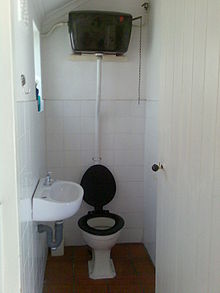Tandas: Perbezaan antara semakan
Mencipta laman baru dengan kandungan 'thumb|Toilet with elevated [[cistern and chain attached to lever of discharge valve.]] [[File:Nota...' |
(Tiada perbezaan)
|
Semakan pada 23:53, 30 Mac 2011
Tandas adalah sistem paip yang tujuan utamanya adalah bagi menyingkir bahan buangan manusia: kencing dan bahan najis. Selain itu, muntah dan buangan haid juga kadang kala dibuang dalam tandas bagi sesetengah kebudayaan. Perkataan tandas menggambarkan mangkuk tersebut dan, terutamanya dalam Inggeris British, bilik yang memiliki mangkuk tandas. Dalam Inggeris Amerika, ini biasanya dikenali sebagai bilik rehat atau bilik air. Perkataan yang kemudiannya seringkali menggambarkan bilik yang turut mengandungi tub mandi. Bilik dengan hanya tandas dan singki kadang kala dikenali sebagai separa-bilik air, separa mandi, atau bilik solek (powder room).



<---- There are two basic types of modern toilets: the dry toilet and the wet (flush) toilet, the latter being the most commonly known and producer of blackwater. The dry toilet needs no plumbing for water input or evacuation, but is often coupled with a ventilation system.
Prior to the introduction of modern flush toilets, most human waste disposal took place outdoors in outhouses or latrines. However, the ancient cities of the Indus Valley Civilization, e.g., Harappa[1] and Mohenjo-daro[2], which are located in present day India and Pakistan, had flush toilets attached to a sophisticated sewage system[3]—and other forms of toilets were used both in the time of the Romans and Egyptians as well.[4] Although a precursor to the modern flush toilet system was designed in 1596 by John Harington,[5] the toilet did not enter into widespread use until the late nineteenth century, when it was adopted in English upper class residences.[6]
>
Jenis tandas
Kebanyakan tandas di negara membangun adalah tandas curah, di mana air membawa kumbahan ke sistem pembentungan.
Rujukan
- ^ Bathing Area, Mohenjo-daro, Sindh<
- ^ Loo and Behold!— A Toilet Museum!, Anurag Yadav, the-south-asian.com, April 2004.
- ^ Kaivot Ja Käymälät: Johdatus Historiaan Esimerkkinä Suomi (A Brief History of Wells and Toilets - The Case of Finland), Petri S. Juuti and Katri J. Wallenius, Tampere University Press, ePublications, Tampere, 2005.
- ^ Who invented the toilet
- ^ A History of the flush toilet
- ^ Poop Culture: How America is Shaped by its Grossest National Product, Dave Praeger, ISBN 1-932595-21-X
Bacaan lanjut
- Flushed with success: new waste-reducing design in modern toiletry by Jim Motavalli. E: The Environmental Magazine, March-April, 1998
- Garden Houses and Privies, Authentic Details for Design and Restoration by Peter Joel Harrison. John Wiley & Sons, 2002. ISBN 0-471-20332-7 Member of the Outhouse Wall of Fame
- Slanguage - a Dictionary of Irish slang by Bernard Share. (Dublin,1997) ISBN 0-7171-2683-8
- Temples of Convenience - And Chambers of Delight by Lucinda Lambton (NPI Media Group, 2006) ISBN 0-7524-3893-X
- Thunder, Flush and Thomas Crapper by Adam Hart-Davis (Michael O'Mara Books, 1997), ISBN 1-57076-081-0.
- Clean and Decent - The Fascinating History of the Bathroom and the Water Closet by Lawrence Wright (Routledge and Kegan Paul, London, 1960).
- Teresi, Dick (2002). Lost Discoveries: The Ancient Roots of Modern Science--from the Babylonians to the Maya. New York: Simon & Schuster. m/s. 351–352. ISBN 0-684-83718-8. Unknown parameter
|coauthors=ignored (|author=suggested) (bantuan) - Compendium of Sanitation Systems and Technologies - freely available PDF.
Pautan luar
| Wikimedia Commons mempunyai media berkaitan: Tandas. |